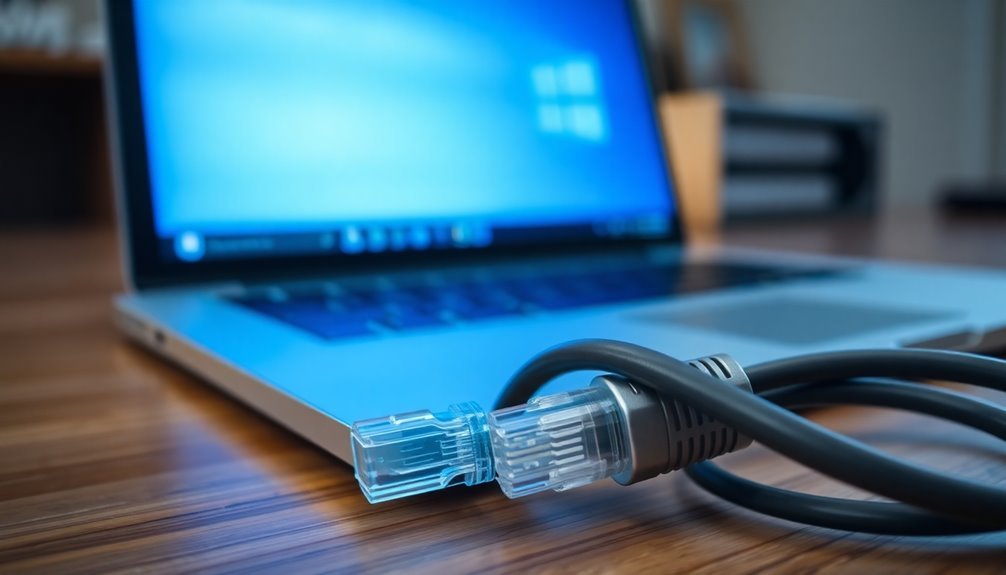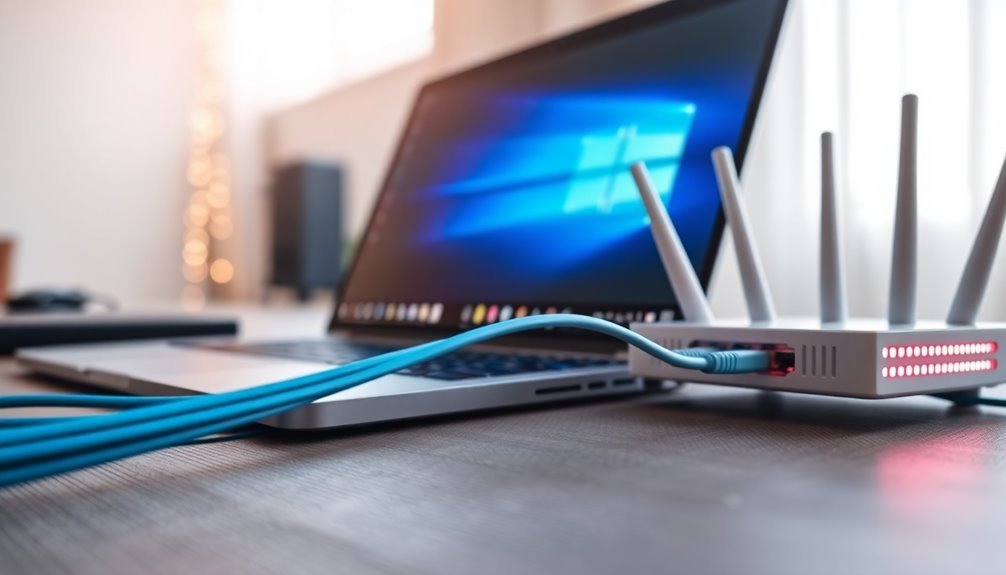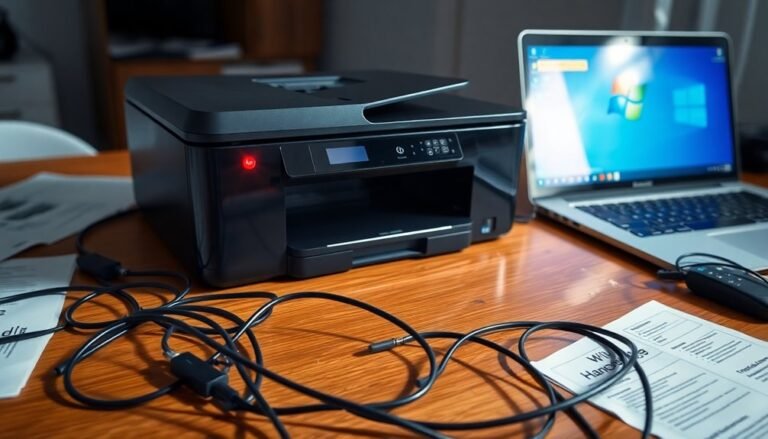Windows 11 Slow File Transfer: Speed Up Network File Transfers

To speed up slow file transfers in Windows 11, connect devices using fast USB 3.0 ports or wired Ethernet instead of Wi-Fi. Updating network and storage drivers can also improve transfer speeds.
Make sure to apply the latest Windows 11 patches and use high-quality cables for better performance. Temporarily disable antivirus scanning or firewall interference during large transfers.
You can try performance tools like TeraCopy or EaseUS Todo PCTrans for more reliable and faster copying. Additionally, optimize network adapter settings and drive configurations for the best results.
Explore further to find advanced fixes and troubleshooting steps to enhance file transfer speeds.
Common Causes of Slow File Transfers in Windows 11

Common Causes of Slow File Transfers in Windows 11: How to Fix Them
If you’re experiencing slow file transfers in Windows 11, several hardware, network, and software issues could be causing the problem. Understanding these common causes will help you speed up your file transfers and improve overall system performance.
1. USB Port and Cable Quality
Using older USB ports like USB 2.0 instead of faster USB 3.0 or 3.1 ports can significantly reduce transfer speeds. Additionally, damaged or low-quality USB cables can cause slowdowns. Always use certified USB 3.0/3.1 cables and connect devices to the appropriate high-speed ports for optimal performance.
2. Outdated or Incompatible Drivers
Slow file transfers often result from outdated or incompatible drivers for USB controllers or storage devices. To fix this, update your drivers through the Windows Device Manager or visit the manufacturer’s website to download the latest driver versions compatible with Windows 11.
3. Storage Device Type
The type of storage device plays a critical role in transfer speeds. Older hard disk drives (HDDs) are much slower compared to modern solid-state drives (SSDs). Upgrading to an SSD can dramatically improve file transfer rates in Windows 11.
4. Network Bandwidth and Hardware
Network-related issues such as bandwidth congestion, outdated routers or switches, duplex mismatches, and outdated firmware can throttle your transfer speeds. For faster network transfers, use wired Ethernet connections instead of Wi-Fi whenever possible, and ensure your network hardware is up-to-date.
5. Firewall and Antivirus Settings
Firewalls and antivirus software that scan network traffic in real-time can introduce latency and slow down file transfers. Temporarily disabling these protections or configuring exceptions for trusted transfers can help improve speeds, but ensure your system remains protected.
6. System Resource Constraints
High CPU usage, insufficient RAM, and resource-intensive background processes can bottleneck input/output operations. Closing unnecessary applications and monitoring system resources can help maintain smooth and fast file transfers.
7. File System and Fragmentation
The choice of file system impacts transfer performance. For example, transferring files on drives formatted with exFAT or NTFS can yield different speeds. Additionally, file fragmentation and transferring many small files instead of fewer large files can also slow down transfers. Running disk defragmentation and consolidating files can optimize performance.
Features like Remote Differential Compression (RDC) enabled on Windows can also slow down file transfers by consuming additional system resources during the process.
By addressing these common causes of slow file transfers in Windows 11, you can enhance your system’s responsiveness and save valuable time during data transfers.
For more Windows 11 optimization tips, regularly check for system updates and maintain your hardware and software.
Fixing SMB Protocol and Remote Differential Compression Issues
Optimize Windows 11 File Sharing: Fix SMB Protocol and Remote Differential Compression Issues
Windows 11 enhances file sharing with modern SMB protocols like SMBv2 and SMBv3, plus advanced features such as Remote Differential Compression (RDC). However, misconfigurations or compatibility problems can cause slow or failed network file transfers.
To improve Windows 11 file sharing performance, start by confirming that SMBv2 or SMBv3 is enabled using PowerShell with the command `Get-SmbServerConfiguration`. Disable the outdated SMBv1 protocol unless you need to connect to legacy devices, as SMBv1 poses significant security risks and is deprecated.
If you experience issues such as System error 53 or the network path not found error when connecting to SMB shares—especially with newer Windows 11 versions—double-check your credential manager entries and group policy settings to ensure compatibility with your SMB server.
For SMB Direct, ensure your network supports RDMA technology. If you experience file transfer failures after network changes, try testing different network shares or toggle SMB Direct and SMB 1.0 settings to pinpoint the issue. Always prioritize SMBv2 or SMBv3 protocols for optimal speed and security.
When dealing with Remote Differential Compression (RDC), verify that RDC is enabled through Windows Features, especially if you transfer large or frequently updated files. If file transfers remain slow or fail, temporarily disable RDC to check for compatibility issues.
After making changes, reboot your system to apply them.
By systematically adjusting SMB protocol settings and RDC options in Windows 11, you can effectively resolve file transfer bottlenecks, enhance network performance, and ensure secure, reliable file sharing.
Follow these best practices to optimize Windows 11 file sharing and fix common SMB and RDC issues.
Updating Drivers and Applying Windows 11 Patches
How to Boost Network File Transfer Speeds by Updating Drivers and Installing Windows 11 Patches
Slow or unstable network file transfers are often caused by outdated drivers and missing Windows 11 system updates. To maximize your file transfer speeds and ensure reliable performance, it’s essential to keep your device drivers and Windows 11 operating system fully up to date.
Why Updating Drivers Improves Network Transfer Speeds
Outdated or corrupted drivers can significantly reduce transfer rates by impairing hardware communication efficiency. Updating USB and network adapter drivers ensures your hardware operates at peak performance, minimizing bottlenecks during file transfers.
The Importance of Installing Windows 11 Updates
Windows 11 cumulative updates frequently include critical networking and driver enhancements that fix bugs and improve bandwidth management. Regularly applying these patches helps maintain compatibility with the latest hardware standards and optimizes network throughput.
Step-by-Step Guide to Keep Your System Updated for Faster Transfers:
- Inspect Hardware Ports: Before updating drivers, physically check USB and network ports for any damage or loose connections that could slow transfers.
- Update Device Drivers: Use Windows Device Manager or download the latest USB and network adapter drivers directly from official manufacturer websites to ensure you have the most stable and efficient versions.
- Install Windows 11 Cumulative Updates: Enable automatic updates or manually install the latest patches to benefit from ongoing improvements in network performance and security.
- Backup Drivers and Schedule Regular Updates: Create backups of your current drivers before updating, and set reminders to routinely check for new updates to prevent future speed degradation.
Optimizing Hardware for Faster File Transfers
Optimizing Hardware for Faster File Transfers: Essential Tips for Maximum Speed
To achieve faster file transfer speeds, start by ensuring your hardware is fully optimized alongside updated drivers and system patches.
Disable drive indexing on HDDs to reduce unnecessary drive workload and pause synchronization services like OneDrive during large file transfers to avoid resource conflicts.
Close unnecessary background applications and utilize PC optimization tools to free up CPU and disk resources. Additionally, switch Windows to “best performance” mode under visual effects settings to allocate more system power for transfers.
For storage optimization, regularly defragment HDDs and scan drives for errors to maintain peak performance.
Enable TRIM on SSDs to sustain their speed over time. Upgrade slow or failing drives to modern SSDs or NVMe drives for significant transfer speed improvements.
Ensure your drive formats and cluster sizes are optimized based on your typical file types for efficient data handling.
When using external drives, connect via USB 3.0 or higher ports with high-quality cables and keep the drive firmware updated.
For internal drives, secure SATA or NVMe connections, consider RAID 0 configurations for enhanced speed, and disable power-saving modes during file transfers to maintain consistent performance.
Enhancing Network Connections and Settings

Boost Network File Transfer Speeds with Optimal Connection and Settings
To maximize network file transfer speeds, it’s essential to optimize your connection type and network settings for enhanced throughput and stability. For the fastest and most reliable connection, choose a wired Ethernet connection or connect to a 5GHz Wi-Fi band, which offers higher speeds and less interference compared to the 2.4GHz band.
On Windows 11, you can easily prioritize the 5GHz Wi-Fi band by navigating to Settings > Network & Internet > Wi-Fi.
Ensure your network drivers and router support gigabit speeds and are updated to the latest firmware for peak performance. Additionally, configuring custom DNS servers like Google DNS (8.8.8.8) can reduce DNS resolution time, while assigning a static IP address helps avoid DHCP-related delays.
Top Tips to Enhance Network File Transfer Performance:
- Prioritize the 5GHz Wi-Fi band or use a wired Ethernet connection for faster, more reliable network speeds.
- Keep your network drivers updated and configure your adapter for gigabit full duplex mode.
- Use custom DNS servers such as Google DNS (8.8.8.8) and set static IP addresses to lower latency and improve connection consistency.
- Disable power-saving features on your network adapter and system to maintain steady throughput during transfers.
Tweaking System Configurations for Improved Performance
How to Optimize Windows 11 for Faster File Transfers and Improved Network Performance
Boost your file transfer speeds and overall network performance on Windows 11 by optimizing system configurations beyond just upgrading your hardware. Follow these proven tips to enhance your PC’s efficiency and ensure smooth, high-speed data transfers.
1. Reduce Visual Effects to Free Up System Resources
Disable Windows 11 animations, shadows, and other visual effects by selecting “Adjust for best performance” in System Properties. This simple adjustment lowers CPU and RAM usage, especially beneficial for PCs with limited memory.
Don’t forget to restart your computer to apply these changes fully.
2. Choose the Right Power Plan for Maximum Performance
Switch your power settings to High Performance or Ultimate Performance mode via Control Panel or Settings. These modes prevent CPU throttling and ensure your network adapters and disks operate at peak efficiency.
Avoid using the Balanced power plan during heavy file transfers to prevent slowdowns.
3. Limit Background Processes and Startup Apps
Free up system resources by disabling unnecessary startup applications and pausing OneDrive syncing during transfers. Use Task Manager to identify and remove unwanted bloatware that could be hogging CPU and memory, ensuring your system focuses on the task at hand.
4. Advanced Tweaks for Expert Users
For those comfortable with system tweaks, optimize TCP window scaling and adjust the IRPStackSize registry settings to improve network throughput. Additionally, disable SMBv1 to enhance security and compatibility with modern devices.
Always back up your registry and test any changes carefully to maintain system stability and security.
By implementing these Windows 11 optimization strategies, you can achieve faster file transfers, better network reliability, and an overall smoother computing experience.
Stay tuned for more tips on maximizing your PC’s performance.
Recommended Tools to Diagnose and Accelerate Transfers
Top Software Tools to Diagnose and Speed Up Network File Transfers on Windows 11
Optimizing network file transfers on Windows 11 requires more than just a well-configured system—it demands the right software tools to diagnose bottlenecks and accelerate transfer speeds effectively.
Leveraging specialized applications helps you maximize bandwidth usage, ensure file integrity, and streamline large or frequent file transfers. Below are the best tools designed to boost your network file transfer performance on Windows 11:
1. EaseUS Todo PCTrans
Optimize your local network file transfers on Windows 11 with EaseUS Todo PCTrans. Featuring an intuitive drag-and-drop interface, this tool enables fast and wireless file migration between PCs while fully utilizing your available bandwidth for maximum speed.
2. AnyViewer
Speed up both local and remote file transfers on Windows 11 using AnyViewer’s multiple simultaneous threads. It supports transferring unlimited file counts and large files, making it ideal for bulk transfers or remote work environments where efficiency matters.
3. Send Anywhere
Send Anywhere offers real-time, cross-platform file transfers with minimal setup on Windows 11. Transfer large files up to 10 GB effortlessly without needing devices to be physically near each other, perfect for quick and secure sharing across different devices.
4. TeraCopy
Enhance transfer reliability and speed on Windows 11 with TeraCopy. This tool integrates seamlessly with Windows Explorer and provides file integrity verification, error recovery, and detailed transfer progress feedback, ensuring your files are copied securely and efficiently.
By incorporating these top-rated Windows 11 file transfer tools, you can diagnose network bottlenecks and accelerate file transfers, improving productivity and file sharing reliability.
Explore these solutions today to optimize your Windows 11 network file transfer experience.
Troubleshooting Persistent File Transfer Slowdowns
Troubleshooting Persistent File Transfer Slowdowns in Windows 11: Effective Tips and Solutions
Are you experiencing slow file transfers on Windows 11? Despite using advanced file transfer tools, persistent slowdowns can occur due to system, network, or configuration issues. Here’s how to improve file transfer speeds and fix Windows 11 slow file transfer problems.
1. Update Windows 11 to the Latest Version****
Ensure your system has the latest Windows updates installed. File transfer slowdowns via SMB were common in early Windows 11 versions but have been resolved in updates like KB5022913 and later.
Keeping Windows updated is crucial for optimal file transfer performance.
2. Check SMB Settings for Performance Impact
SMB signing and encryption enhance security but may reduce file transfer speeds due to CPU overhead. If your environment permits, consider disabling SMB signing and encryption to boost transfer rates.
3. Update Network Drivers and NAS Firmware****
Outdated network drivers and NAS firmware often cause drastic speed drops after Windows 11 upgrades. Visit your hardware manufacturer’s website to download and install the latest drivers and firmware for improved network performance.
4. Enable Network Offloading Features (RSS and LSO)
Receive Side Scaling (RSS) and Large Send Offload (LSO) help maximize network throughput. Verify these features are enabled on your network adapter to enhance file transfer speeds.
5. Optimize Disk Performance
Defragment your disks regularly to improve read/write speeds during transfers.
Also, minimize background processes that may consume system resources and slow down file operations.
6. Manage Antivirus Settings During Transfers
Real-time antivirus scanning can significantly reduce file transfer speeds. Temporarily disable real-time scanning or configure exclusions for transfer folders to avoid unnecessary scanning delays.
7. Disable Remote Differential Compression (RDC)
RDC can cause slowdowns in certain scenarios. Disable Remote Differential Compression in Windows Features to potentially improve file transfer performance.
8. Check USB Drivers and Ports for External Drives****
If transferring files to external drives, ensure USB drivers are up to date and use high-speed ports (USB 3.0 or higher) to avoid bottlenecks.
By following these Windows 11 file transfer troubleshooting tips, you can resolve persistent slowdowns and enjoy faster, more reliable file transfers.
Stay proactive with updates and configuration checks to maintain optimal performance.
Frequently Asked Questions
Can Windows 11 Slow File Transfers When Copying Files to Cloud Storage Services?
Yes, Windows 11 can slow file transfers to cloud storage. You’ll experience bottlenecks from system processes, network settings, driver issues, or limited resources. Always update drivers, optimize settings, and choose high-performance cloud providers for faster, more consistent uploads.
Does File Fragmentation Impact Transfer Speeds in Windows 11?
Yes, file fragmentation slows transfer speeds in Windows 11 if you’re using an HDD, since the disk must perform extra seek operations. If you use an SSD, fragmentation has little impact, so you won’t notice a slowdown.
Are Transfer Speeds Affected by Windows 11 Power-Saving or Sleep Settings?
Yes, you’ll notice transfer speeds drop or pause if Windows 11’s power-saving or sleep settings activate. Disable sleep mode, USB selective suspend, and power-saving features on drives and network adapters to maintain steady, uninterrupted file transfers.
Can User Account Permissions Restrict or Throttle File Transfer Speeds?
About 30% of network transfer slowdowns can be traced to security software running under user permissions. While your account settings don’t directly throttle speed, restrictive permissions or aggressive antivirus scans can greatly delay or limit file transfers.
Is There a Way to Schedule Large File Transfers for Off-Peak Hours in Windows 11?
Yes, you can schedule large file transfers for off-peak hours in Windows 11 using Task Scheduler. Just set up a task to run a file transfer script, like Robocopy or FreeFileSync, at your preferred time.
Conclusion
Picture your files zipping smoothly across your network, no more crawling progress bars or stalled transfers. By updating drivers, tweaking network settings, and optimizing your hardware, you’re turning your Windows 11 PC into a high-speed hub. Tackle SMB protocol issues, use diagnostic tools, and keep your system patched—each step brings you closer to seamless file movement. Now, you can confidently move large files and folders, knowing you’ve set the stage for rapid, reliable transfers every time.





